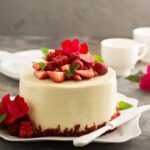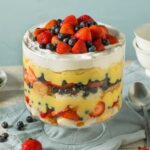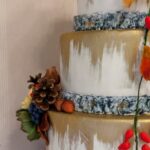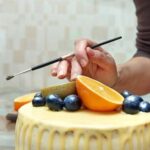How do you make edible glue for cake decorating? Edible glue is a crucial component in cake decorating, serving as the adhesive that keeps fondant decorations in place, secures cake layers, and aids in creating intricate sugar flowers.
While there are pre-made edible glues available in stores, making your own can offer many benefits. In this article, we will explore the different types of edible glue, the advantages of DIY glue, the ingredients needed, step-by-step instructions for making it at home, and expert tips for successful results.
When it comes to cake decorating, having the right type of edible glue can make all the difference. Common varieties include royal icing, gum paste glue, and tylose glue – each serving a specific purpose in securing various elements on a cake. Making your own edible glue not only allows for customization based on your preferences but also proves to be more cost-effective than continuously purchasing store-bought options.
Homemade edible glue offers unique advantages, from being able to adjust its consistency to suit your needs to ensuring that it is free from any potentially harmful additives. By using simple ingredients like tylose powder, water, and confectioners’ sugar, you can create a reliable adhesive that will elevate your cake decorating projects.
In the following sections, we will delve into the process of making edible glue at home, provide essential tips for success, and explore creative ways to utilize this versatile tool in your cake designs.
Types of Edible Glue
When it comes to cake decorating, edible glue plays a crucial role in ensuring that all the intricate details and decorations stay in place. There are several types of edible glue that are commonly used by bakers and decorators, each with its own unique properties and applications. Understanding the differences between these types of edible glue can help you choose the right one for your specific decorating needs.
1. Royal Icing: Royal icing is a classic choice for edible glue in cake decorating. Made from egg whites or meringue powder and confectioners’ sugar, this type of glue dries quickly and provides a strong bond. It is often used to attach piped decorations, such as borders, flowers, and lettering, to cakes and cookies.
2. Gum Paste Glue: Gum paste glue is another popular option for cake decorators. This type of edible glue is made by mixing water with gum paste or gum tragacanth powder until a thick paste forms. Gum paste glue is ideal for securing heavier decorations, such as fondant figurines or 3D elements, onto cakes without causing them to collapse.
3. Tylose Glue: Tylose glue is a versatile adhesive that is commonly used in sugar flower making and other advanced cake decorating techniques. To make tylose glue, simply mix tylose powder with water until it reaches a thick consistency. This type of edible glue dries clear and flexible, making it perfect for delicate decorations like sugar flowers or intricate icing work.
Experimenting with different types of edible glues can enhance your cake decorating skills and allow you to customize your creations according to your preferences. Whether you opt for royal icing, gum paste glue, tylose glue, or decide to make your own homemade edible glue, the key is to find the right balance between strength, flexibility, and drying time to achieve professional-looking results every time.
Remember that creating your own homemade edible glue can be a cost-effective alternative to store-bought options while giving you complete control over the ingredients used in your decorations. In the next section, we will delve into how you can make your own edible glue for cake decorating at home using simple ingredients like tylose powder, water, and confectioners’ sugar.
Benefits of Homemade Edible Glue
Making your own edible glue for cake decorating can offer various benefits compared to store-bought options. One of the main advantages is cost-effectiveness. By creating your own edible glue at home, you can save money in the long run, especially if you frequently engage in cake decorating projects. Purchasing commercial edible glue can be expensive, while making it yourself allows you to control the cost by using readily available ingredients.
Another significant advantage of homemade edible glue is customization. When you make your own edible glue, you have the flexibility to adjust the consistency and strength according to your specific needs. Whether you require a thicker glue for securing heavy decorations or a thinner consistency for delicate detailing, you can tailor your homemade edible glue to suit each decorating task precisely.
Moreover, making your own edible glue gives you the freedom to experiment with different ingredients and create personalized variations. You can explore various recipes using tylose powder, water, and confectioners’ sugar as base ingredients and add flavorings or coloring agents for unique results. This level of customization allows you to elevate your cake decorating projects and unleash your creativity in new and exciting ways.
- Save money by making your own edible glue
- Customize the consistency and strength of the glue
- Experiment with different ingredients for personalized variations
Ingredients Needed
Making your own edible glue for cake decorating can be a game-changer in the world of baking. Not only does it allow you to have full control over the ingredients used, but it also offers a more cost-effective solution compared to store-bought options. By creating your own edible glue, you can ensure that your cakes and pastries are not only visually stunning but also safe for consumption.
Tylose Powder
One of the key ingredients needed to make edible glue for cake decorating is tylose powder. This powder is essential for creating a strong adhesive that will securely attach decorations to your cakes or hold together intricate sugar creations. Tylose powder helps the glue set quickly, allowing you to work efficiently without worrying about things falling apart.
Water
Another crucial ingredient for making edible glue is water. While it may seem simple, the amount and quality of water used can significantly impact the consistency and effectiveness of your edible glue. It is essential to use clean, room temperature water to achieve the desired adhesive properties in your glue mixture.
Confectioners’ Sugar
Confectioners’ sugar, also known as powdered sugar or icing sugar, acts as a thickening agent in edible glue recipes. This ingredient helps create a smooth and workable consistency that can be easily applied to various cake decorations. The confectioners’ sugar also adds a touch of sweetness to the edible glue without altering its adhesive properties.
By combining these key ingredients in the right proportions, you can create a reliable and versatile edible glue that will elevate your cake decorating projects to new heights. Experiment with different ratios and techniques to find the perfect formula that works best for your specific needs and preferences when embellishing sweet treats with fondant accents or intricate sugar decorations.
Step-by-Step Instructions
One of the essential elements in successful cake decorating is edible glue, which helps to securely attach decorations and components to your cake. Making your own edible glue can be both cost-effective and allow for customization based on your specific needs. So, how do you make edible glue for cake decorating at home?
To make your own edible glue, you will need a few key ingredients: tylose powder, water, and confectioners’ sugar. These simple components can come together to create a versatile adhesive that works well with various types of cake decorations. The process of making edible glue at home is straightforward but requires attention to detail in measurements and mixing techniques.
First, you will need to mix a small amount of tylose powder with water to create a smooth paste. Then, gradually add confectioners’ sugar while stirring continuously until the mixture reaches the desired consistency.
It is crucial to ensure that the edible glue is not too thick or too runny, as this can affect its adhesive properties when used in cake decorating. With careful measurement and proper mixing techniques, you can create a homemade edible glue that suits your specific cake decorating needs.
In addition to being cost-effective, making your own edible glue allows you to have more control over the consistency and strength of the adhesive. By following these step-by-step instructions and experimenting with different ratios of ingredients, you can tailor your edible glue to work best for attaching various decorations or securing cake layers.
Homemade edible glue opens up a world of possibilities for creativity in cake decorating while providing a reliable bonding agent for all your dessert creations.
Tips and Tricks
Making your own edible glue for cake decorating can be a game-changer in your baking endeavors. Not only is it cost-effective, but it also gives you the freedom to customize the glue according to your needs. Whether you want a stronger adhesive for intricate fondant work or a thinner consistency for delicate sugar flowers, homemade edible glue allows you to have full control over your decorating process.
So, how do you make edible glue for cake decorating? Let’s delve into some expert tips and tricks to ensure success.
One essential tip when making edible glue is to store it properly to maintain its quality and usability. Store the prepared edible glue in an airtight container at room temperature, away from direct sunlight or heat sources. This will help prevent the glue from drying out or developing mold. Additionally, make sure to stir or shake the glue well before each use to ensure that the ingredients are evenly mixed, especially if it has been stored for a while.
Consistency is key when it comes to edible glue for cake decorating. Depending on your project, you may need a thicker or thinner consistency of glue. To adjust the consistency of your edible glue, simply add more water or tylose powder in small increments until you achieve the desired thickness. Remember that different techniques and decorations may require varying consistencies of edible glue, so don’t hesitate to experiment and find what works best for your specific needs.
| Edible Glue Tips | Details |
|---|---|
| Proper Storage | Store in airtight container away from sunlight |
| Consistency Adjustment | Add water or tylose powder incrementally |
Using Edible Glue in Cake Decorating
When it comes to cake decorating, edible glue is a versatile and essential tool that can help bring your creations to life. Whether you are attaching delicate fondant decorations, securing multiple cake layers, or crafting intricate sugar flowers, edible glue plays a crucial role in ensuring everything stays in place. But how do you make edible glue for cake decorating?
Attaching Fondant Decorations
One of the most common uses for edible glue in cake decorating is attaching fondant decorations. Whether you are adding small details like flowers and leaves or larger pieces like bows and figures, edible glue provides a strong bond that keeps everything securely in place. To make your own edible glue for this purpose, simply combine water with tylose powder until you achieve a thick, paste-like consistency.
Securing Cake Layers
Another important use of edible glue in cake decorating is securing multiple cake layers together. Whether you are stacking two layers for a tiered cake or creating a sculpted design with various components, edible glue helps hold everything together. To create a sturdy adhesive for this purpose, mix tylose powder with water and allow the mixture to thicken before applying it between the cake layers.
Creating Sugar Flowers
For those looking to take their cake decorating skills to the next level, creating sugar flowers is a beautiful and delicate art form that requires precision and patience. Edible glue is an essential tool for assembling these intricate floral designs, as it provides a secure bond between each petal and component. Making your own edible glue for this purpose is simple – just combine water with tylose powder and mix until you achieve the desired consistency.
Overall, using edible glue in cake decorating opens up endless possibilities for creative expression and design. By understanding how to make your own customized edible glue at home, you can enhance your cakes with secure attachments, intricate details, and stunning embellishments that will truly impress your guests. So why not give it a try and see the difference that homemade edible glue can make in your next cake decorating project?
Conclusion
In conclusion, the art of cake decorating can truly be elevated when utilizing edible glue to secure fondant decorations, attach sugar flowers, or even stack cake layers with finesse. While there are various types of edible glue available in the market, making your own at home can offer numerous benefits. Not only is it cost-effective, but it also allows for customization according to your preferences and needs.
By following a simple recipe using ingredients like tylose powder, water, and confectioners’ sugar, you can create a versatile edible glue that will enhance your cake decorating skills. The step-by-step instructions provided in this blog post guide you through the process of making edible glue with precision and clarity. Additionally, expert tips and tricks ensure that you achieve the perfect consistency and storage techniques for your homemade edible glue.
As you embark on your next cake decorating project, consider trying your hand at making edible glue from scratch. Not only will you have full control over the quality and quantity of the product, but you will also gain a deeper understanding of the intricate artistry involved in creating beautiful and delicious cakes.
Experimenting with different uses of edible glue in cake decorating can open up a world of new possibilities and creativity for both novice bakers and experienced professionals alike. Give it a try and see how adding homemade edible glue to your baking arsenal can take your creations to the next level.
Frequently Asked Questions
How Do You Make Edible Cake Glue?
To make edible cake glue, you can simply mix together powdered sugar and water until you achieve a thick consistency that will hold your cake decorations in place. This homemade edible glue is easy to make and works effectively for most cake decorating needs.
What Is a Good Substitute for Edible Glue?
A good substitute for edible glue in cake decorating is royal icing. Royal icing is made from confectioners’ sugar, egg whites, and flavoring. It dries hard and acts as a strong adhesive for attaching fondant decorations or securing gingerbread houses.
What Is the Best Edible Glue for Cakes?
The best edible glue for cakes is tylose glue or gum paste glue. These are specifically designed for culinary use and provide a strong bond to keep decorations in place on your cakes without affecting the taste or texture of your creations.
Tylose glue is easy to make by mixing tylose powder with water until you get a thick, sticky consistency perfect for attaching fondant details securely on your cakes.

Welcome to my blog about home and family. This blog is a place where I will share my thoughts, ideas, and experiences related to these important topics. I am a stay-at-home mom with two young children. I hope you enjoy reading it! and may find some helpful tips and ideas that will make your home and family life even better!





